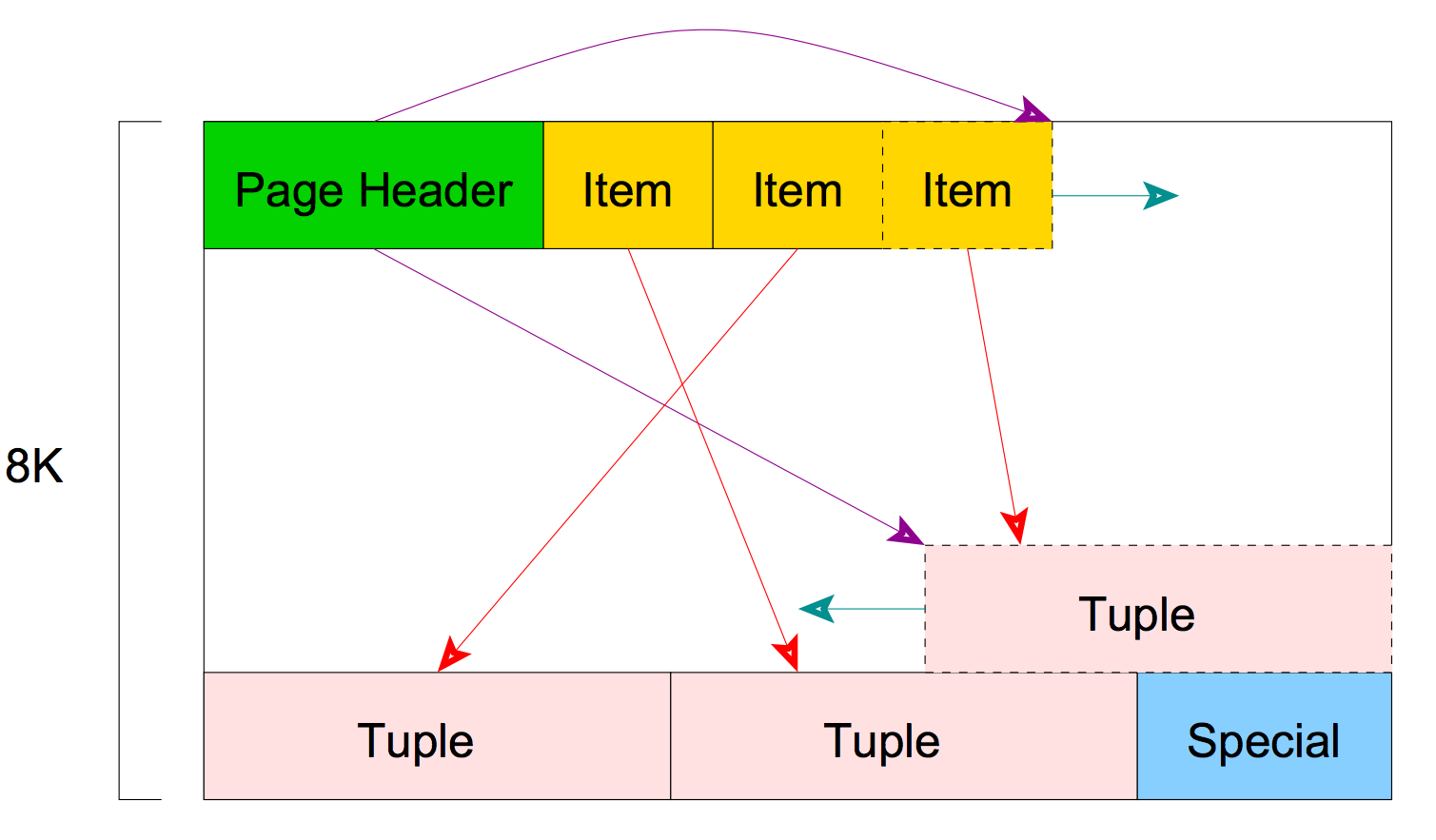邮政和表格内部组织
邮政和表格内部组织
提问于 2020-01-22 14:13:10
我找到了一个解释,解释了postgresql的内部工作原理。以下是一幅图片:

以及以下解释:
标题之后的
项是一个数组标识符,它由指向实际项的(偏移量、长度)对组成。
因为一个项目标识符在被释放之前是不会移动的,所以它的索引可以长期使用来引用一个项目,甚至当项目本身在页面上移动以压缩空闲空间时也是如此。指向项的指针称为CTID (ItemPointer),由PostgreSQL创建,它由一个页码和项目标识符的索引组成。
你能帮我把这几件事弄清楚吗?
我说得对吗?页面标题附近的项目是CTID本身或项,而CTID是不同的东西吗? rows?
- Depending
- 做CTID从来不移动,或者在答案上使用CTID,也许我会理解以下的确切含义:“因为一个项目标识符在被释放之前永远不会移动,它的索引可以长期地用于引用一个项,即使当项目本身在页面上移动以压缩空闲空间时。”然而,更详细的解释会更好。
回答 1
Stack Overflow用户
回答已采纳
发布于 2020-01-22 16:34:10
在图片中被称为“项目”的是PostgreSQL术语中的“行指针”。它在src/include/storage/itemid.h中定义。
/*
* A line pointer on a buffer page. See buffer page definitions and comments
* for an explanation of how line pointers are used.
*
* In some cases a line pointer is "in use" but does not have any associated
* storage on the page. By convention, lp_len == 0 in every line pointer
* that does not have storage, independently of its lp_flags state.
*/
typedef struct ItemIdData
{
unsigned lp_off:15, /* offset to tuple (from start of page) */
lp_flags:2, /* state of line pointer, see below */
lp_len:15; /* byte length of tuple */
} ItemIdData;
typedef ItemIdData *ItemId;这些行指针就存储在页面标题之后的数组中。
参见src/include/storage/bufpage.h中的优秀文档
/*
* A postgres disk page is an abstraction layered on top of a postgres
* disk block (which is simply a unit of i/o, see block.h).
*
* specifically, while a disk block can be unformatted, a postgres
* disk page is always a slotted page of the form:
*
* +----------------+---------------------------------+
* | PageHeaderData | linp1 linp2 linp3 ... |
* +-----------+----+---------------------------------+
* | ... linpN | |
* +-----------+--------------------------------------+
* | ^ pd_lower |
* | |
* | v pd_upper |
* +-------------+------------------------------------+
* | | tupleN ... |
* +-------------+------------------+-----------------+
* | ... tuple3 tuple2 tuple1 | "special space" |
* +--------------------------------+-----------------+
* ^ pd_special
*
* NOTES:
*
* linp1..N form an ItemId (line pointer) array. ItemPointers point
* to a physical block number and a logical offset (line pointer
* number) within that block/page. Note that OffsetNumbers
* conventionally start at 1, not 0.
*
* tuple1..N are added "backwards" on the page. Since an ItemPointer
* offset is used to access an ItemId entry rather than an actual
* byte-offset position, tuples can be physically shuffled on a page
* whenever the need arises. This indirection also keeps crash recovery
* relatively simple, because the low-level details of page space
* management can be controlled by standard buffer page code during
* logging, and during recovery.回答您的问题:
- 元组的
ctid是物理地址,由块号(从0开始)和行指针(从1开始)组成。您可以从表行的ctid中识别行指针:这是第二个数字。例如,(321,5)将是第322页上的第5行指针。 - 块中实际元组的位置不是固定的:它存储在
lp_off中。这允许PostgreSQL在块中移动数据,而不更改元组的物理地址(tid)。正如上面所解释的那样,实际的数据可以在块中移动,但是行指针不会改变。元组的ctid是存储在索引中的内容。语句现在应该清楚了。
页面原文内容由Stack Overflow提供。腾讯云小微IT领域专用引擎提供翻译支持
原文链接:
https://stackoverflow.com/questions/59861645
复制相关文章
相似问题

